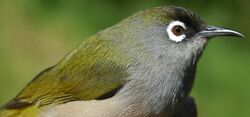Biology:Réunion olive white-eye
| Réunion olive white-eye | |
|---|---|

| |
| Scientific classification | |
| Domain: | Eukaryota |
| Kingdom: | Animalia |
| Phylum: | Chordata |
| Class: | Aves |
| Order: | Passeriformes |
| Family: | Zosteropidae |
| Genus: | Zosterops |
| Species: | Z. olivaceus
|
| Binomial name | |
| Zosterops olivaceus (Linnaeus, 1766)
| |
| Synonyms | |
|
Certhia olivacea Linnaeus, 1766 | |
The Réunion olive white-eye (Zosterops olivaceus) is a species of bird in the family Zosteropidae. It is found on Réunion. Its natural habitats are boreal forests and subtropical or tropical high-altitude grassland.
In 1760 the French zoologist Mathurin Jacques Brisson included a description of the Reunion olive white-eye in his Ornithologie based on a specimen that had been brought to Paris from Île Bourbon (now Réunion), but which Brisson mistakenly believed had been collected in Madagascar. He used the French name Le grimpereau olive de Madagascar and the Latin Certhia Madagascariensis Olivaceus.[2] Although Brisson coined Latin names, these do not conform to the binomial system and are not recognised by the International Commission on Zoological Nomenclature.[3] When in 1766 the Swedish naturalist Carl Linnaeus updated his Systema Naturae for the twelfth edition, he added 240 species that had been previously described by Brisson.[3] One of these was the Reunion olive white-eye. Linnaeus included a brief description, coined the binomial name Certhia olivacea and cited Brisson's work. He followed Brisson and gave the type location as Madagascar instead of Réunion.[4] This species is now placed in the genus Zosterops that was introduced by the naturalists Nicholas Vigors and Thomas Horsfield in 1827.[5] There are no recognised subspecies.[6]
References
- ↑ BirdLife International (2016). "Zosterops olivaceus". IUCN Red List of Threatened Species 2016: e.T22714000A94396989. doi:10.2305/IUCN.UK.2016-3.RLTS.T22714000A94396989.en. https://www.iucnredlist.org/species/22714000/94396989. Retrieved 13 November 2021.
- ↑ Brisson, Mathurin Jacques (1760) (in French, Latin). Ornithologie, ou, Méthode contenant la division des oiseaux en ordres, sections, genres, especes & leurs variétés. 3. Paris: Jean-Baptiste Bauche. pp. 625–626, Plate 33 fig 1. https://biodiversitylibrary.org/page/35953728. The two stars (**) at the start of the section indicates that Brisson based his description on the examination of a specimen.
- ↑ 3.0 3.1 Allen, J.A. (1910). "Collation of Brisson's genera of birds with those of Linnaeus". Bulletin of the American Museum of Natural History 28: 317–335.
- ↑ Linnaeus, Carl (1766) (in Latin). Systema naturae : per regna tria natura, secundum classes, ordines, genera, species, cum characteribus, differentiis, synonymis, locis. 1, Part 1 (12th ed.). Holmiae (Stockholm): Laurentii Salvii. p. 185. https://biodiversitylibrary.org/page/42946381.
- ↑ Vigors, Nicholas Aylward; Horsfield, Thomas (1827). "Australian birds in the collection of the Linnean Society; with an attempt at arranging them according to their natural affinities" (in English, Latin). Transactions of the Linnean Society of London 15 (1): 170–334 [234]. doi:10.1111/j.1095-8339.1826.tb00115.x. https://biodiversitylibrary.org/page/778483. The title page is dated 1826.
- ↑ Gill, Frank; Donsker, David, eds (2018). "Sylviid babblers, parrotbills, white-eyes". World Bird List Version 8.1. International Ornithologists' Union. http://www.worldbirdnames.org/bow/sylvias/.
Wikidata ☰ Q2627930 entry
 |


